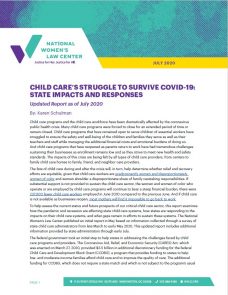Abortion rights, women of color, and LGBTQIA+ people are under attack. Pledge to join us in fighting for gender justice.
 Child care programs and the child care workforce have been dramatically affected by the coronavirus public health crisis. Many child care programs were forced to close for an extended period of time or remain closed. Child care programs that have remained open to serve children of essential workers have struggled to ensure the safety and well-being of the children and families they serve as well as their teachers and staff while managing the additional financial costs and emotional burdens of doing so. And child care programs that have reopened as parents return to work have had tremendous challenges sustaining their businesses as enrollment remains low and as they strive to meet new health and safety standards. The impacts of this crisis are being felt by all types of child care providers, from centers to family child care homes to family, friend, and neighbor care providers.
Child care programs and the child care workforce have been dramatically affected by the coronavirus public health crisis. Many child care programs were forced to close for an extended period of time or remain closed. Child care programs that have remained open to serve children of essential workers have struggled to ensure the safety and well-being of the children and families they serve as well as their teachers and staff while managing the additional financial costs and emotional burdens of doing so. And child care programs that have reopened as parents return to work have had tremendous challenges sustaining their businesses as enrollment remains low and as they strive to meet new health and safety standards. The impacts of this crisis are being felt by all types of child care providers, from centers to family child care homes to family, friend, and neighbor care providers.
The fate of child care during and after the crisis will, in turn, help determine whether relief and recovery efforts are equitable, given that child care workers are predominantly women and disproportionately women of color and women shoulder a disproportionate share of family caretaking responsibilities. If substantial support is not provided to sustain the child care sector, the women and women of color who operate or are employed by child care programs will continue to bear a steep financial burden; there were 237,000 fewer child care workers employed in June 2020 compared to the previous June. And if child care is not available as businesses reopen, most mothers will find it impossible to go back to work.
To help assess the current status and future prospects of our critical child care sector, this report examines how the pandemic and recession are affecting state child care systems, how states are responding to the impacts on their child care systems, and what gaps remain in efforts to sustain these systems. The National Women’s Law Center published an initial report in May based on information collected through a survey of state child care administrators from late March to early May 2020. This updated report includes additional information provided by state administrators through early July.
